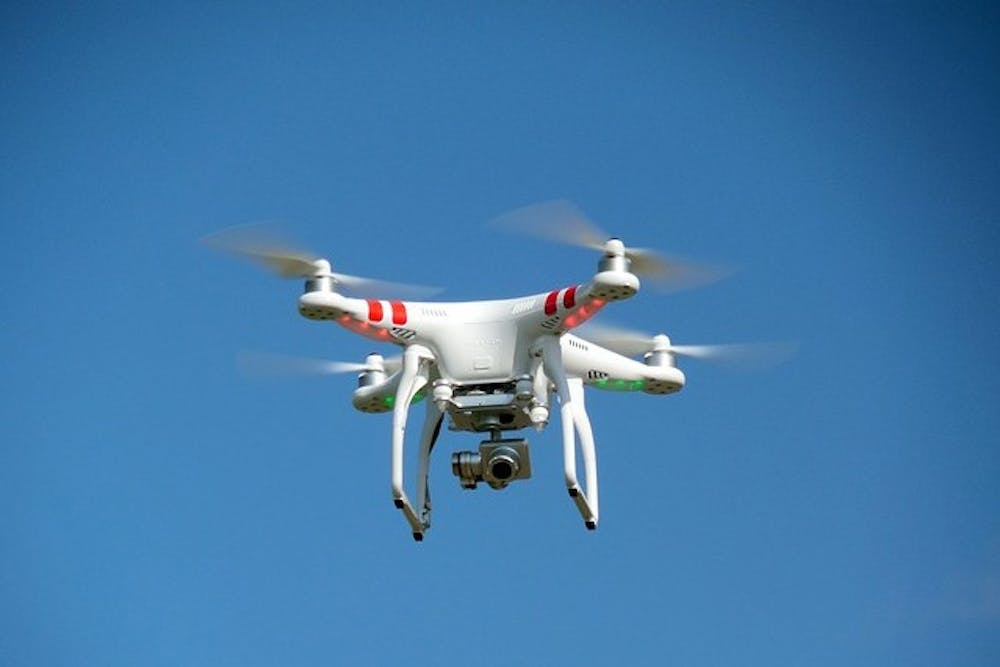
Despite controversy, Penn's GRASP lab continues research on autonomous drones with the aid of a $5.5 million grant from the Department of Defense | Courtesy of Pixabay user succo/Creative Commons
A new research grant could reopen controversy around drone research at Penn.
Earlier this month, Penn’s groundbreaking General Robotics, Automation, Sensing and Perception Laboratory received a $5.5 million Department of Defense grant to develop autonomous flying robots that could be used in the military’s drone program.
Established in 1979, the GRASP Lab has long been a center of robotics innovation and systems research and was already working on autonomous systems when it received the grant from the military’s Defense Advanced Research Project Agency.
The development and military use of drones has long attracted controversy on college campuses, including Penn’s. Last spring, a coalition of Penn student groups launched a movement calling for divestment from companies that profit from displacing people through war or violence, including at least one drone manufacturer.
Meanwhile, a local organization, Brandywine Peace Community, has been campaigning against drones for years. This year alone, Brandywine held two public demonstrations against the GRASP Lab’s drone research, during the Penn Relays in April and Homecoming earlier this month.
“[The] University of Pennsylvania is a major military researcher in robotics and drone applications,” demonstration organizer Marge Van Cleef wrote on Brandywine’s website. “Let the UPenn community and the public know what else in taking place at UPenn.”
But while the lab may receive military funding, GRASP’s research remains purely academic. That means that anything it does with the grant, like all research conducted at Penn, will be subject to the stringent standards and protocols that govern Penn research.
“Research that is performed under grants from the Department of Defense is governed by the same principles as projects funded by other federal funding institutions,” Office of the Vice Provost for Research Director of Research Initiatives Michael Borda said in an email statement.
Borda added that Penn faculty who receive Department of Defense funding are free to publish and share their research and that other scholars can access and discuss such data.
Additionally, the new grant specifically calls for automated robots that are capable of finding and choosing targets independently and without human intervention. This contrasts with conventional drones, which require at least one pilot to operate them, albeit from a distance.
This distinction can make the conversation more complicated, Penn Law School professor Claire Finkelstein said. Autonomous systems like the ones GRASP is building can challenge traditional notions of responsibility if something goes wrong.
“Suppose an autonomous weapons system goes and kills somebody it’s not supposed to kill. Who’s responsible if the autonomous weapons system has made its own decision?” Finkelstein said. “Is it the designer of the system? Is it the programmer of the system who builds the system according to specific designs? Is it the person who deploys the system knowing its design and its capacities?”
Nevertheless, she believes that automated systems, if applied to weapons technology, can have valuable applications, namely by limiting the number of human soldiers that are put in harm’s way during combat.
“If it can be done safely and in a way that maintains meaningful human control, you are taking another flesh and blood human being out of harm’s way,” Finkelstein said.
Finkelstein also emphasized the difference between basic research and its use by subsequent scientists. For example, while the GRASP Lab is ostensibly creating autonomous flying robots with a humanitarian use, there is nothing stopping the military from using that technology in a future weapon. That future use, however, is out of the GRASP researchers’ control.
“Because of the nature of technology, there may be a dual use for the research they engage in. What purposes people put the research to in the future is nothing that anyone can control,” Finkelstein said.
If the GRASP Lab’s research is one day converted into weaponry, it won’t take place at Penn. Weapons research is typically classified and conducted in secrecy away from a university’s main facilities. Penn has not engaged in such research for decades.
“The only grants that researchers at Penn are getting from the Department of Defense are essentially grants to work on really basic science or analysis,” political science professor Michael Horowitz said.
Horowitz, who used to work at the Department of Defense, also sees potential value in applying robotics research to military technology.
“One of the benefits of some of these technologies is that as they become more reliable and more precise, they help the American military not just be more effective but be more effective in a way that reduces collateral damage and civilian casualties in war,” Horowitz said.
He added that it is important to distinguish between military drones that are used for combat and those used for surveillance in war zones. The majority of military drone operations perform surveillance, and fewer drones can fire missiles than many people realize.
“It’s the drone strikes that make the news,” Horowitz said.
The Daily Pennsylvanian is an independent, student-run newspaper. Please consider making a donation to support the coverage that shapes the University. Your generosity ensures a future of strong journalism at Penn.
DonatePlease note All comments are eligible for publication in The Daily Pennsylvanian.





